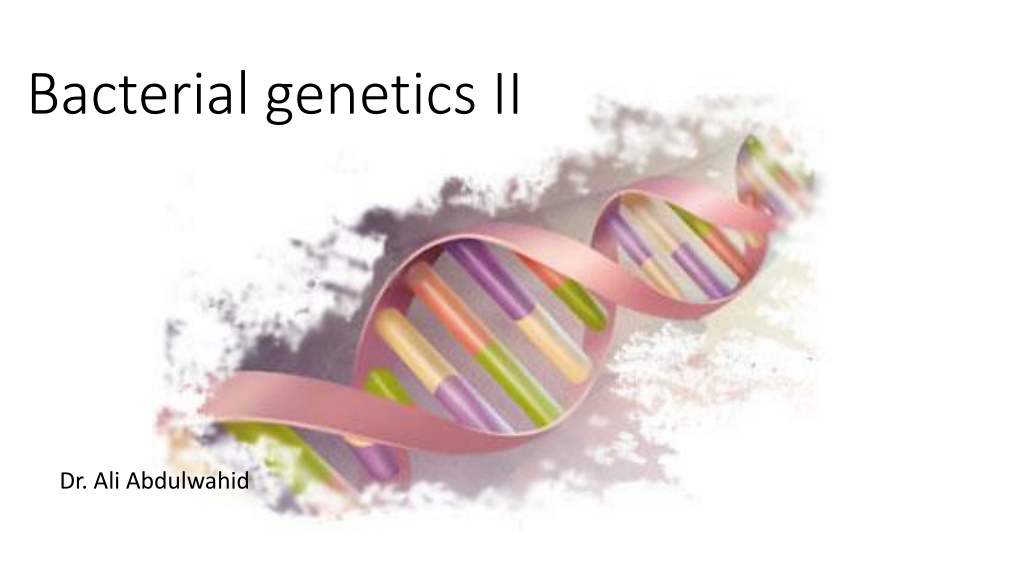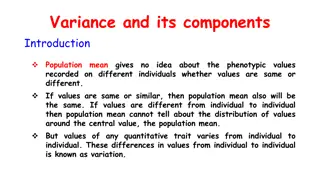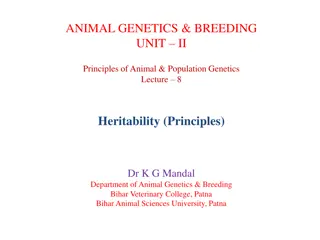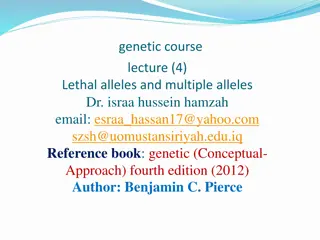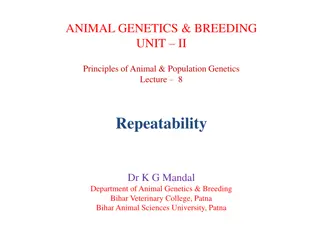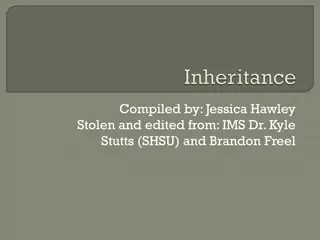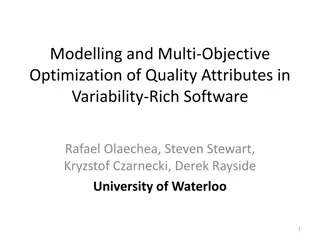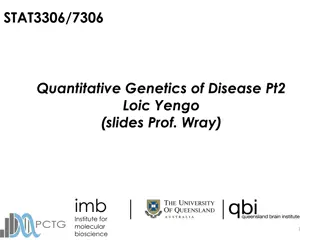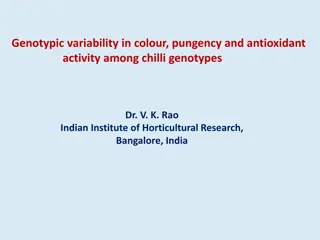Understanding Bacterial Genetics: Phenotypic and Genotypic Variability
Phenotypic and genotypic variations in bacteria are crucial for their adaptation and survival. Phenotype reflects the physical expression influenced by both the genome and the environment, while genotype represents the hereditary constitution passed to offspring. Mutations are a primary source of genotypic variability, leading to different effects in cells. Mutations can be spontaneous or induced by various agents, such as UV rays or chemicals. Different types of mutations, like point mutations and frameshift mutations, can alter the genetic code, affecting protein synthesis. Understanding these genetic variations is essential for studying bacterial evolution and behavior.
Download Presentation

Please find below an Image/Link to download the presentation.
The content on the website is provided AS IS for your information and personal use only. It may not be sold, licensed, or shared on other websites without obtaining consent from the author. Download presentation by click this link. If you encounter any issues during the download, it is possible that the publisher has removed the file from their server.
E N D
Presentation Transcript
Bacterial genetics II Dr. Ali Abdulwahid
Phenotypic and genotypic Variability of Bacteria
Overview Overview 1.Phenotypic variation : phenotype : The physical expression of various characters by bacterial cells in a given environment. These properties are determined by its genome and by environment. It is reversible, temporary and not inheritable Example : production of the enzyme beta-galactosidase by the bacterium E. coli when it is grown in a medium containing lactose. When grown in a medium containing glucose only, the enzyme is not synthesized.
2.Genotypic variation : Genotype : It is the hereditary constitution of the cell that is transmitted to its progeny Its heritable, stable and does not affected by environment Genotypic variability may occur due to different mechanisms include : 1.mutations 2.Intercellular transfer of genomic material
1. Mutation It is random, undirected, heritable variation caused by an alteration in the nucleotide sequences at some points of the DNA of the cell due to addition, deletion or substitution of one or more bases. During DNA replication, some errors may occur during copying the progeny strands For instance, instead of thymine bonding to adenine, it binds to guanine Different mutations in the a particular gene may produce different effect in the cell
Types of Mutation Mutations can be divided conveniently into: A. Spontaneous mutation: occur spontaneously in nature in the absence of any mutation-causing agents. B. Induced mutation: enhanced by exposure of cells to several agent (mutagens) include : 1. Physical agents: (i) UV rays; (ii) lionizing radiation, e.g. X-rays 2. Chemical agents: Alkylating agents, Acridine dyes and Nitrous acid.
Point mutations: affect just one point (base pair) in a gene. Leads to change to or substitution of a different base pair. Alternatively, can result in the deletion or addition of a base pair. It is in general, reversible and is of two classes: 1. Base pair substitution 2. Frameshift mutations (insertion or deletion):
1. Base pair substitution: Depending on the placement of the substituted base, can be divided into : silent mutation , cause no change in the amino acid of the protein missense mutation , lead to the insertion of the wrong amino acid nonsense mutation , lead to generate a stop codon and prematurely terminating the protein synthesis (the polypeptide) Silent mutation Nonsense mutation Missense mutation DNA Protein DNA Protein
2. Frameshift mutations (insertion or deletion): If the number of bases inserted or deleted is not a multiple of three, there will be shift in the reading frame (codons sequence), forming newest of triplet codon. the new codons will specify the incorrect amino acids, or leading to premature termination for the translation process (truncated protein) Frameshift mutations INSERTION DELETION
2- Intercellular transfer of genomic material Horizontal gene transfer : DNA can be transferred from one organism to another, and that DNA can be stably incorporated in the recipient cell, permanently changing its genetic composition. This Process is so called horizontal gene transfer to differentiate it from the inheritance of parental genes, a process called vertical inheritance. Three broad mechanisms mediate efficient movement of DNA between bacterial cells : Conjugation Transduction transformation.
Conjugation A process in which one cell, the donor or male cell, makes contact with another, the recipient or female cell DNA is transferred directly from the donor into the recipient Certain types of plasmids, known as transfer factors or sex factors, carry the genetic information necessary for conjugation to occur. These are also called self-transmissible plasmids, and they can mobilize other plasmids or portions of the chromosome for transfer. Only cells that contain such a plasmid can act as donors; those lacking a sex factor act as recipients. Such Plasmid codes for specialized fimbria (sex pilus) which projects from the surface of the cell. The tip of the pilus attaches to the surface of a recipient cell and holds the two cells together so that DNA can then pass into the recipient cell. A male and a female cell joined by a pilus (sex pilus).
1. Plasmid transfer Bacterial Populations can be divided into two types of cells. 1. F+ : the donor cell, contains an Fertility plasmid or F plasmid and is designated F+. 2. F : the recipient cell, does not contain this plasmid and is called F . DNA is transferred only in one direction, from F+ to F F Factor or F plasmid (Fertility Factor) Is a transfer factor that contains the genetic information necessary for the synthesis of the sex pilus (Conjugation tube), and for self- transfer.
Mechanism of DNA transfer during conjugation. A. Connection between two bacterial cells by means of sex pili.. Formation of a specific conjugal bridge between donor cell and receptor cell. An endonuclease cleaves one strand of the circular DNA double helix at a specific point . The single strand with the leader region enters the recipient cell. The double-stranded structure of both the transferred single strand and the remaining DNA strand is restored by means of complementary DNA synthesis. The recipient cell, now plasmid-positive, is called a transconjugant cell. B. C. D.
2. Chromosomal transfer The F factor in some cases can be integrated into the host chromosome in a very small proportion of F+ cells, creating : high frequency recombination (Hfr) donor cells In which, the entire chromosome behaves like an F+ plasmid chromosomal genes (fragments) can be transferred (from the site of insertion) in a direction determined by the orientation of insertion in the normal sex factor manner to a recipient cell at a relatively high frequency
Medically Important Factors Transferred by Conjugation Medically Important Factors Transferred by Conjugation 1. Colicinogenic (Col) Factor Several strains of coliform bacteria produce colicins antibiotic-like substances which are specifically and selectively lethal to other enterobacteria. Colicin production is determined by a plasmid called the Col factor, which resembles the F factor in promoting conjugation, leading to self-transfer and, at times, transfer of chromosomal segments. 2. Resistance Factors or R Plasmids Resistance factors (R factors) are plasmids that have significant medical importance as it leads to the spread of multiple drug resistance among bacteria. This R plasmid consists of two components: RTF+r determinants. Resistance transfer factor (RTF): The transfer factor thatis responsible for conjugal transfer. Resistance determinant (r): code for resistance against various drugs. The whole plasmid (RTF+r determinants) is known as the R factor An R factor can have several r determinants, and resistance to as many as eight or more drugs can be transferred simultaneously.
Transduction The transfer of a portion of the DNA from one bacterium to another by a bacteriophage Bacteriophages are viruses that parasitise bacteria and consist of a nucleic acid core and a protein coat. Bacteriophages exhibit two types of life cycle. (1) Virulent or lytic cycle; (2) Temperate or nonlytic cycle: Virulent or lytic cycle: virus attached to the bacterial surface, inject its DNA inside the bacterial cell , its DNA then controls the bacterial cell activity to synthesis phage particles large numbers of progeny phages are built up inside the host bacterium, which ruptures to release them.
During the assembly of bacteriophage progeny inside infected bacteria, packaging errors may occur occasionally. A phage particle may have at its core a segment of the host DNA besides its own nucleic acid. When this particle infects another bacterium, DNA transfer is effected and the recipient cell acquires new characteristic coded by the donor DNA. Bacterial genes have been transduced by the phage into the second cell
Temperate or nonlytic cycle Temperate or nonlytic cycle In the temperate or nonlytic cycle, the host bacterium is unharmed. The phage DNA becomes integrated with the bacterial chromosome as prophage, and is replicated stably as part of the host cell chromosome and is transferred to the daughter cells. This process is called lysogeny and bacteria harboring prophages are called lysogenic bacteria. the prophage behaves as an additional segment of the bacterial chromosome, coding for new characteristic
Medical Importance of transduction 1. Toxigenicity in diphtheria bacilli: Diphtheria bacilli acquire toxigenicity (and therefore virulence) by lysogenization with the phage beta. Elimination of the phage from a toxigenic strain renders it nontoxigenic. 2. Production of staphylococci, streptococci and clostridia toxins: It is probable that the production of many toxins by staphylococci, streptococci and clostridia is also dependent upon lysogenic conversion by specific bacteriophages. In transduction, the phage acts only as a vehicle carrying bacterial genes from one cell to another but in lysogenic conversion the phage DNA itself is the new genetic element.
Transformation Is the uptake of exogenous DNA by living bacteria from surrounding environment Bacterial cells that have such ability called competent cells Competence can be naturally developed or induced artificially. Natural competence is unusual among bacteria, and some of these strains are require the presence of competence factors, produced only at a specific point in the growth cycle competence factors (an activating protein) is released by competent cell to induce competence in non- competent cells (may involve proteins that are involved in the assembly of type IV pili as well as DNA translocase complex at the cytoplasmic membrane). Naturally competent bacteria are found in very few genera include Bacillus subtilis, Haemophilus influenzae, Neisseria gonorrhoeae, Neisseria meningitidis, and Streptococcus pneumoniae.
The main steps of bacterial transformation are: Transforming DNA + Competent cells Binding Resistance to exogenous Dnase Fragmentation and uptake Integration Adapted from : http//www.lamission.edu>lifesciences> chapter 8: microbial genetics Expression
Reference Jawetz, M. & Adelberg s. 2019. Medical Microbiology , Twenty-Sixth Edition. The McGraw-Hill Companies, Inc. USA Kumar, S. 2012. Textbook of microbiology. Jaypee Brother Medical Publishers (P) Ltd. New Delhi, India. Kayser, F.H., Bienz, K.A., Eckrt, J. and R. M. Zinkernagel. 2005. Medical Microbiology. GeorgThieme Verlag. Stuttgart, Germany. Passarge, E. 2001. Color atlas of genetics. GeorgThieme Verlag. Stuttgart, Germany. http//www.lamission.edu/lifesciences/chapter 8: Microbial genetics
